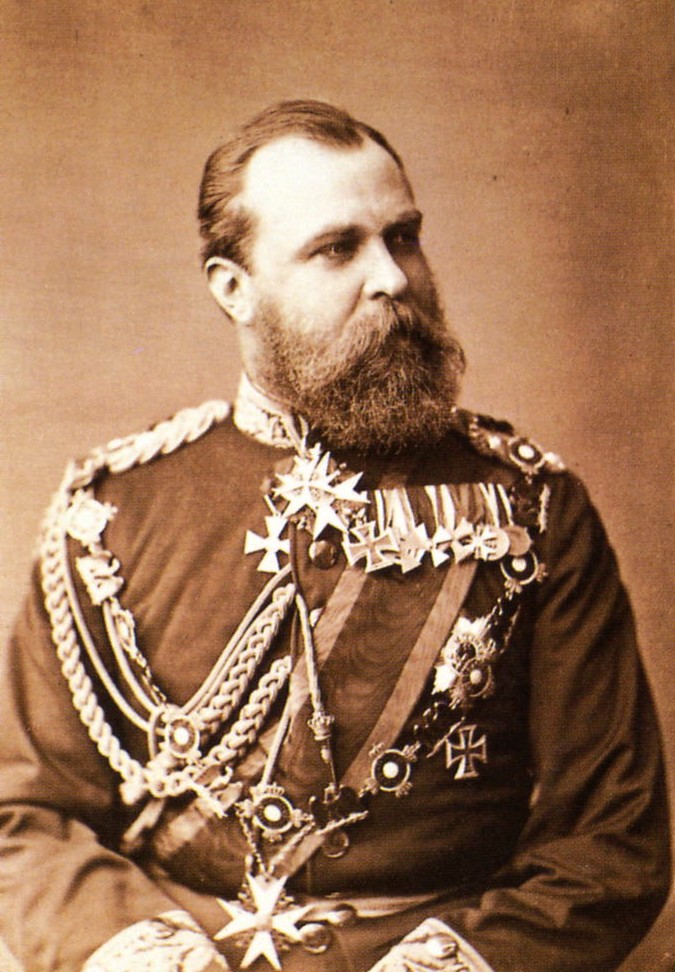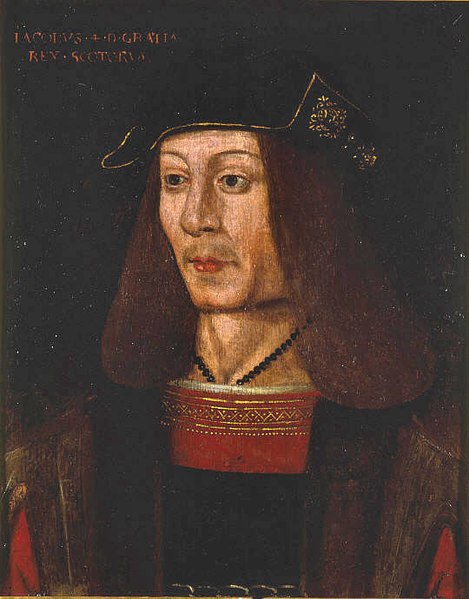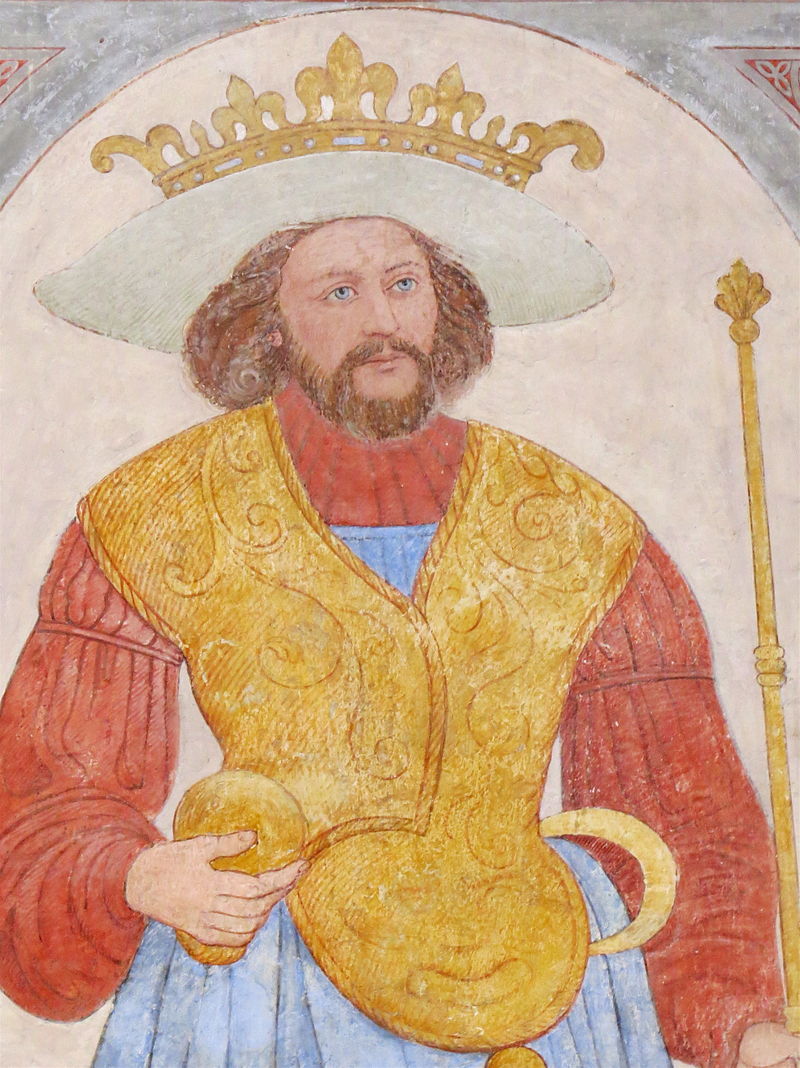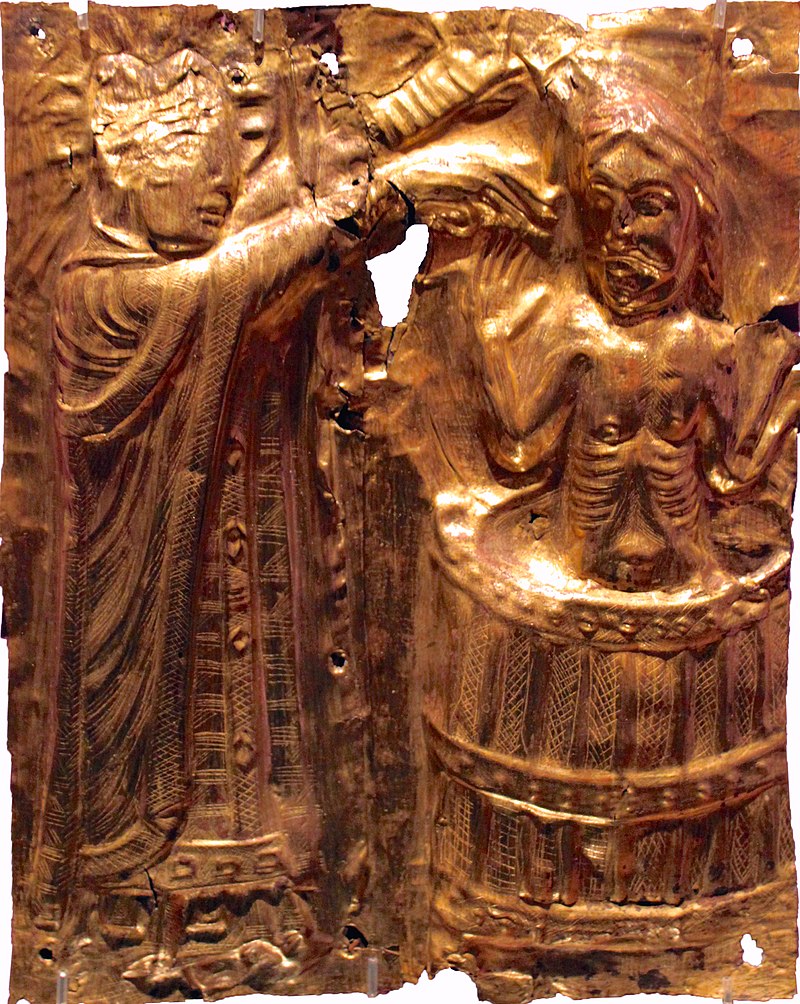© Unofficial Royalty 2025

Ludwig IV, Grand Duke of Hesse and by Rhine; Credit – Wikipedia
March 13, 1669 – Death of Maria Ilyinichna Miloslavskaya, Tsaritsa of All Russia, first wife of Alexei I, Tsar of All Russia; first buried at the Ascension Convent, a Russian Orthodox nunnery in the Moscow Kremlin, in 1929 moved to the crypt of the Archangel Cathedral in the Moscow Kremlin
In 1648, Maria Ilyinichna married Alexei I, Tsar of All Russia. They had thirteen children including two Tsars of All Russia, Fyodor III and Ivan V, and Sophia Alexeevna, who served as Regent for her brother Ivan V and half-brother Peter I (the Great). During this period, the life of Russian noblewomen, including the Tsaritsa of All Russia, was not a public one. They were expected to live in seclusion with little contact with men. Maria Ilyinichna was mainly involved in charitable and religious activities such as donating to facilities for the poor, sick, and disabled. On March 13, 1669, 45-year-old Maria Ilyinichna died of puerperal fever (childbed fever) five days after her most difficult childbirth. Her thirteenth child Yevdokia Alexeevna lived for only two days.
Unofficial Royalty: Maria Ilyinichna Miloslavskaya, Tsaritsa of All Russia
March 13, 1741 – Birth of Joseph II, Holy Roman Emperor at Schönbrunn Palace in Vienna, Austria
Full name: Joseph Benedict August Johannes Anton Michel Adam
Joseph II reigned from 1765 to 1790 as Holy Roman Emperor after being elected Holy Roman Emperor following the death of his father Franz I, Holy Roman Emperor in 1765. He was co-ruler with his mother Archduchess Maria Theresa of Austria, the only woman to be ruler of the Habsburg hereditary lands in her own right, from 1765 – 1780 of Bohemia, Hungary, Croatia, Austria, and several other Habsburg hereditary lands. He was the sole ruler from 1780 to 1790, following the death in 1780 of his mother. Joseph married three times. His three wives and his three daughters all predeceased him.
Unofficial Royalty: Joseph II, Holy Roman Emperor, King of Bohemia, King of Hungary and Croatia, Archduke of Austria
March 13, 1767 – Death of Maria Josepha of Saxony, Dauphine of France, the second wife of Louis, Dauphin of France, at the Palace of Versailles in Versailles, France; buried at the Cathedral of Saint-Étienne in Sens, France
Maria Josepha was the daughter of Augustus III, Elector of Saxony, King of Poland and Grand Duke of Lithuania and Maria Josepha of Austria. In 1747, fifteen-year-old Maria Josepha married seventeen-year-old Louis, Dauphin of France, the son and heir apparent of his father Louis XV, King of France. They had eight children, including three Kings of France. Maria Josepha’s husband Louis never succeeded to the throne, dying of tuberculosis in 1765 at the age of 36. Maria Josepha, who had cared for Louis during his last illness, also contracted tuberculosis. She died at the Palace of Versailles, on March 13, 1767 at the age of 35, and was buried with her husband.
Unofficial Royalty: Maria Josepha of Saxony, Dauphine of France
March 13, 1808 – Death of King Christian VII of Denmark and Norway in Rendsborg, then in Denmark, now in Schleswig-Holstein, Germany; buried at Roskilde Cathedral in Roskilde, Denmark
Christian VII was the only surviving son of King Frederik V of Denmark and Norway and his first wife Princess Louisa of Great Britain, and also a grandson of King George II of Great Britain. In 1766, Christian succeeded to the Danish and Norwegian thrones after the early death of his father at age 42. That same year he married his first cousin Princess Caroline Matilda of Wales, daughter of Christian’s deceased maternal uncle Frederick, Prince of Wales. The couple had two children, but, probably, Christian was not Louise Auguste’s father. Because of Carolina Matilda’s affair with Christian’s physician Johann Friedrich Struensee, Struensee was beheaded. Twenty-year-old Caroline Matilda lost her title of Queen and was forcibly separated from her children whom she never saw again. She was sent to Celle in her brother’s Kingdom of Hanover and lived the rest of her life at Celle Castle. Christian VII’s reign was marked by mental illness and for most of his reign, he was only nominally king. His half-brother Hereditary Prince Frederik was regent of Denmark in 1772-1784. From 1784 until Christian VII’s death, Christian’s son, later Frederik VI, acted as regent. On March 13, 1808, King Christian VII died from a stroke at the age of 59.
Unofficial Royalty: King Christian VII of Denmark
March 13, 1879 – Wedding of Prince Arthur, Duke of Connaught, son of Queen Victoria, and Princess Louise Margaret of Prussia at St. George’s Chapel, Windsor Castle
In 1878, Arthur met Princess Louise Margaret of Prussia on a visit to his eldest sister Victoria, German Crown Princess and Crown Princess of Prussia. Louise Margaret was friendly with the Crown Princess and her eldest daughter Charlotte. Queen Victoria considered Louise Margaret to be a less than satisfactory possible bride for her son. She was plain-looking and had bad teeth. Her parents were unpleasant, had an unhappy marriage, and lived apart. Queen Victoria wanted to avoid associating her family with a possible scandal. However, because Arthur was so happy at the prospect of marrying Louise Margaret, Queen Victoria remained open-minded. When Queen Victoria met Louise Margaret, she became more positive and the engagement was announced.
Unofficial Royalty: Wedding of Prince Arthur, Duke of Connaught and Princess Louise Margaret of Prussia
March 13, 1881 – Assassination of Alexander II, Emperor of All Russia when a bomb is thrown at him near the Winter Palace in St. Petersburg, Russia; buried at the Peter and Paul Cathedral in St. Petersburg
Of the twenty Romanov monarchs, five died violent deaths (Ivan VI, Peter III, Paul I, Alexander II, and Nicholas II). Alexander II was riding in a bomb-proof carriage, a gift from Emperor Napoleon III of France. As the carriage turned onto the Catherine Canal Embankment, a bomb was thrown. The carriage was damaged and several onlookers were wounded, but the emperor was unharmed. Next, Alexander II made a mistake that cost him his life. Unaware that another conspirator was leaning against a railing about six feet away, he left the carriage to inspect the damage and check on the wounded people, and a bomb was thrown directly between the emperor’s legs. The noise from the bomb was deafening, smoke filled the air, wounded people were screaming, and the snow was drenched with blood. When the smoke cleared, Alexander II lay mortally wounded, his legs crushed and torn from the blast of the bomb. Alexander asked to be taken to the Winter Palace so he could die there. Just the day before he died, Alexander II had completed plans to create an elected parliament and he intended to release these plans within a few days. Perhaps if Alexander II had lived Russia would have become a constitutional monarchy and not been led down the path the country ultimately took. Alexander II’s son and successor Alexander III was very conservative and reversed some liberal reforms of his father. One of the first things he did as emperor was to tear up his father’s plans for an elected parliament and cancel the order his father had signed the day he died.
Unofficial Royalty: Assassination of Alexander II, Emperor of All Russia
Unofficial Royalty: Alexander II, Emperor of All Russia
March 13, 1892 – Death of Ludwig IV, Grand Duke of Hesse and by Rhine at Neues Palais in Darmstadt, Grand Duchy of Hesse and by Rhine, now in Hesse, Germany; buried in the New Mausoleum, Rosenhöhe Park in Darmstadt
Ludwig was married to Princess Alice of the United Kingdom, daughter of Queen Victoria. They had seven children, including Alix, Empress Alexandra Feodorovna, wife of Nicholas II, Emperor of All Russia. Ludwig and Alice were the great-grandparents of Prince Philip, Duke of Edinburgh. Ludwig succeeded his childless uncle as Grand Duke of Hesse and by Rhine in 1877. At the end of 1878, Ludwig’s family, except his wife Alice and his daughter Ella, came down with diphtheria. Alice nursed her family back to health, and all survived except for their youngest daughter May. Sadly, Alice eventually also became ill and was unable to fight off the illness, and died on December 14, 1878. Ludwig survived his wife by fourteen years, dying of a heart attack, on March 13, 1892, at the age of 54.
Unofficial Royalty: Ludwig IV, Grand Duke of Hesse and by Rhine
March 13, 1900 – Birth of Queen Sālote Tupou III of Tonga at the Royal Palace in Nukuʻalofa, Tonga
Famed for her stature (6 feet 3 inches, 270 pounds) and her appearance at the coronation of Queen Elizabeth II of the United Kingdom, Queen Sālote Tupou III of Tonga was the first Queen Regnant of the Kingdom of Tonga and its longest-reigning monarch.
Unofficial Royalty: Queen Sālote Tupou III of Tonga
March 13, 1948 – Death of Princess Helena Victoria of Schleswig-Holstein, granddaughter of Queen Victoria, at Fitzmaurice Place, Berkeley Square in London, England; buried at Frogmore Burial Ground in Windsor, England
Helena Victoria, known as Thora, was the daughter of Princess Helena, Queen Victoria’s daughter, and Prince Christian of Schleswig-Holstein. Thora never married and remained at home until her mother died in 1923. Following her mother’s example, Thora was involved in many charities and organizations. These included the YMCA, YWCA, and Princess Christian’s Nursing Home in Windsor (established by her mother). She was also, with her sister Marie Louise, an avid supporter of the arts, and often held small concerts and performances at their various homes. Thora’s last years were spent rather quietly. In 1941, she was named godmother to Prince William of Gloucester, elder son of the Duke and Duchess of Gloucester, to whom she was quite close. In November 1947, she made her last major public appearance at the wedding of Princess Elizabeth and Philip Mountbatten. Princess Helena Victoria died four months later, on March 13, 1948, at the age of 77.
Unofficial Royalty: Princess Helena Victoria of Schleswig-Holstein
March 13, 1957 – Death of Grand Duchess Elena Vladimirovna of Russia, Princess Nicholas of Greece, daughter of Grand Duke Vladimir Alexandrovich of Russia and wife of Prince Nicholas of Greece, in Athens, Greece; buried at the Royal Cemetery, Tatoi Palace, Greece
Elena was the only daughter of Grand Duke Vladimir Alexandrovich of Russia and Marie of Mecklenburg-Schwerin. Through her father, she was the granddaughter of Alexander II, Emperor of All Russia, niece of Alexander III, Emperor of All Russia, and first cousin of Nicholas II, Emperor of All Russia. In 1902, Elena married her second cousin Prince Nicholas of Greece, the son of King George I of Greece and Grand Duchess Olga Konstantinovna of Russia. The couple had three daughters, including Princess Marina of Greece who married Prince George, Duke of Kent. Because of the political situation in Greece, members of the Greek royal family, including Elena and her husband, were often in exile. The Greek monarchy was restored in 1935, and the following year, Elena and Nicholas returned to Greece. Having suffered from declining health for several years, Prince Nicholas died in 1938. Elena remained in Greece throughout World War II. Elena and her sister-in-law, Princess Andreas of Greece (the former Princess Alice of Battenberg), worked with the Red Cross during World War II to organize shelters and nurses in the poor neighborhoods of Athens. Elena lived the rest of her life in Greece, enjoying a close relationship with King Paul and Queen Friederike, and a particularly close bond with the future King Constantine II. She died at her home in Athens on March 13, 1957.
Unofficial Royalty: Grand Duchess Elena Vladimirovna of Russia, Princess Nicholas of Greece
March 13, 1981 – Birth of Grand Duke George Mikhailovich of Russia in Madrid, Spain, the only child of Grand Duchess Maria Vladimirovna of Russia, a disputed pretender to Headship of the Russian Imperial Family and the throne of Russia since 1992
Grand Duke George Mikhailovich of Russia, also known as Prince George of Prussia through his father Prince Franz Wilhelm of Prussia, a great-grandson of Wilhelm II, German Emperor and King of Prussia), is the heir to his mother Grand Duchess Maria Vladimirovna of Russia, a disputed pretender to the Headship of the Russian Imperial Family and the throne of Russia since 1992. The Headship of the Russian Imperial Family and succession to the former Russian throne has been in dispute, mainly due to disagreements over whether marriages in the Romanov family were equal marriages – a marriage between a Romanov dynast and a member of a royal or sovereign house. In 2021, George married Rebecca Virginia Bettarini, Director of the Russian Imperial Foundation in a civil ceremony in Moscow, Russia, on September 24, 2021, followed by a religious wedding on October 1, 2021, at Saint Isaac’s Cathedral in St. Petersburg, Russia. It was the first Romanov wedding held in Russia since the Russian Revolution.
Unofficial Royalty: Grand Duke George Mikhailovich of Russia
March 13, 2017 – Death of Richard, 6th Prince of Sayn-Wittgenstein-Berleburg, husband of Princess Benedikte of Denmark, at his home, Berleburg Castle in Bad Berleburg, North Rhine-Westphalia, Germany; buried at Forest Cemetery Sengelsberg in Berleburg
Richard, 6th Prince of Sayn-Wittgenstein-Berleburg was the husband of Princess Benedikte of Denmark. In 1919, Germany stopped recognizing the various titles of the nobility and royalty. However, in Germany today former hereditary titles are allowed only as part of the surname. Richard and Benedikte were married in 1968 and they had three children. Richard was active in several conservation programs including a project to reintroduce European bison on his 30,000-acre estate. Richard died at his home, Berleburg Castle, on March 13, 2017, at the age of 82.
Unofficial Royalty: Richard, 6th Prince of Sayn-Wittgenstein-Berleburg
This article is the intellectual property of Unofficial Royalty and is NOT TO BE COPIED, EDITED, OR POSTED IN ANY FORM ON ANOTHER WEBSITE under any circumstances. It is permissible to use a link that directs to Unofficial Royalty.









 (
(




